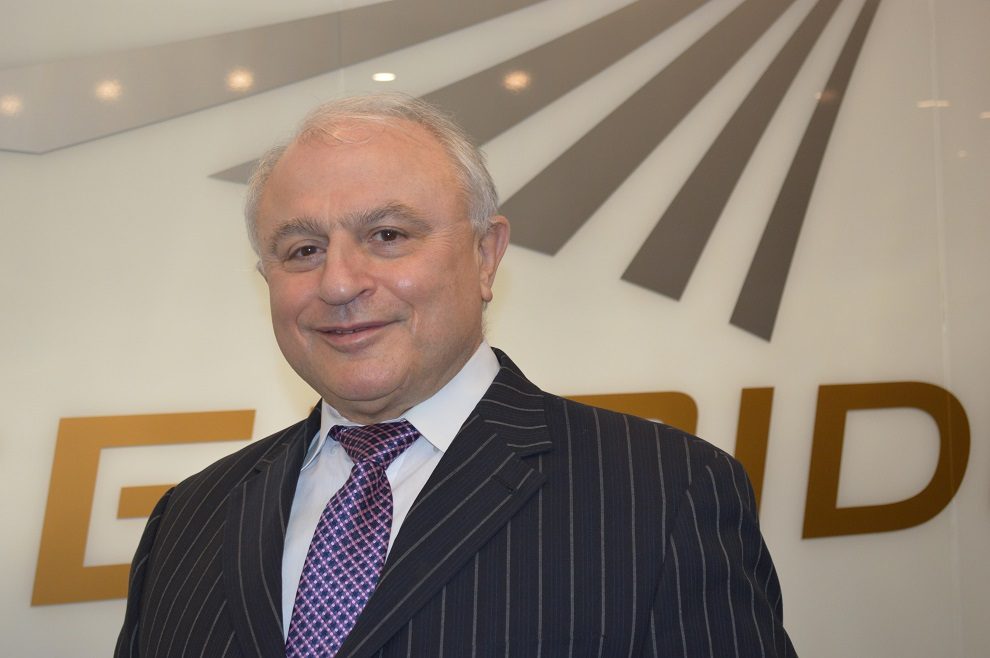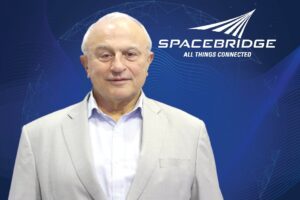Teletimes: How did the year 2021 play out for the satellite industry especially in context to the global pandemic that hit the world?
David Gelerman: 2021 presented unique challenges for the Satellite industry. Serious delays in the worldwide supply chain were observed across the globe, as COVID continues to affect work environments and slows manufacturing, logistics, etc. The launch of new services utilizing the emerging Very High Throughput Satellites (VHTS GEO) and new constellations, like mPower, alternate MEO constellations and many LEO constellations will continue to move forward through 2022 and beyond. SpaceBridge has remained vigilant regarding fulfilling the needs of our customers. Our amazing team continues to deliver new products, working remotely with just as much dedication as they did prior to the pandemic, and continue to innovate – I would say, even harder. I am very proud of our team for our persistent pursuit of innovation, quality, reliability and regulatory compliance for all our products and solutions. Our products are not only market relevant, they provide our customers with the capability to make their operations flexible, versatile and agile, allowing them to rapidly deploy new applications without new investments.
TT: What was the major project and achieved by SpaceBridge in the last year?
DG: Though 2020 and 2021 remained uniquely challenging, it has led us towards a strong growth trajectory.
During the year in the region we won the tender and provided to Space Communication Technologies – SCT, the leading VSAT operator in the Sultanate of Oman, the SpaceBridge’s ASAT-II, WaveSwitch™, the platform on which to operate the Ka-band multi-spot beam HTS and provide Multi Service, Universal Broadband satellite network connectivity, including multiple verticals such as Mobile Network 2G/3G/4G Cellular Backhauling for Urban and Rural areas, consumer broadband connectivity, Enterprise, Defense, Maritime and Oil & Gas. We worked very closely with our esteem partner SCT to put together the most innovative and advanced VSAT network existing in the region, and enable real Broadband Connectivity across the territory of the Sultanate of Oman and beyond.
Despite the challenges COVID has presented, we are expanding and hiring additional team members for key positions and seeking top talent and continue in our tradition of delivering cutting edge solutions through innovations. In terms of technology and products, we took the opportunity to review our portfolio, revamp our plans for new terminals and service offerings and realign our strategy for the new markets, in line with our core competencies. Our focus is to simplify our customers’ lives from a financial investment perspective, bandwidth efficiency and also technically; assisting them in reducing the overall Total Cost of Ownership (TCO) of the new ground segment platforms and technologies throughout innovative implementation of creative business structures. We have remained focused on the evolution of our WaveSwitch™ solution. SpaceBridge ASAT™ WaveSwitch™, is a first in-class innovative, award-winning technology that enables dynamic return link selection and switching to the most appropriate waveform, based on traffic patterns of running applications. WaveSwitch™ enables our customers to define custom tailored triggers that are programmed and then implemented by Artificial Intelligence (AI) to select the appropriate waveform: MF-TDMA, A-SCPC, and SCPC based on real-time traffic patterns, priorities and bandwidth availability to maximize the bandwidth utilization and reduce the congestion due to the oversubscription. This in turn optimizes satellite resource usage and reduces cost and while also improving the user experience. Real-time waveform switching provides ample savings for applications and results in drastic traffic density changes, such as cellular backhaul and trunking. We have continued our efforts to provide improved end-to-end platform efficiencies in the Datalink layers by innovating new compression mechanisms and in the physical layer we have improved dynamic high arrays of MODCODs, both in the Forward and Return Links, providing very efficient TCO. We have also added several new hardware platforms with advanced computing capabilities, enabling value added services to be provided in EDGE computing devices. We can confidently disclose that our HTS experience is profoundly enabling end-to-end Layer 2 connectivity, including Q-in-Q, integrating with MPLS or SD-WAN network services.
TT: How important are partnerships going to be, going in the new decade to bridge the digital divide and connect the unconnected?
DG: SpaceBridge welcomes all kinds of partnerships that can secure and execute initiatives that effectively provide quality, affordable solutions for our customers. It is true that competition makes for a stronger industry, and when we are able to combine efforts on joint missions, we make large strides towards closing the digital divide. Ultimately, it comes down to the cost of the solutions and time-to-market. We bring a complete platform solution of our own, but in many cases it makes more sense to leverage the experience, market reach, and manufacturing capabilities of our partners that specialize in certain areas. We would like to remind our present and prospective partners that as a SATCOM powerhouse, SpaceBridge holds the unique end-to-end integration capabilities to provide our customers with a complete, flexible and comprehensive ground segment solution. We are very pleased with the various business ventures we are part of, whether made possible by revenue share or managed services. These offerings enable us to provide a good price point and excellent performance, and end users choose our solutions and services for these reasons.
TT: How is SpaceBridge helping its customers monetize upon the offering of their value-added services?
DG: On the services front, we launched a new service that offers seamless connectivity on a pay-by-the-byte basis with little or no upfront CapEx. We are actively engaged with several partners for providing connectivity over several regions. In addition to the savings that are made possible by WaveSwitch, where waveform switching provides substantial savings for applications with drastic traffic density changes, such as cellular backhaul and trunking. SpaceBridge also provides autonomously managed services for our customers. These services help eliminate initial large CapEx investments and save on network management OpEx, while also speeding time-to-market.
TT: Can you tell us a bit how SpaceBridge is assisting in providing backhaul connectivity over satellite to unserved remote areas without or limited cellular coverage in Africa?
DG: SpaceBridge is working with the largest MNO in Africa to provide connectivity to unserved communities that are equipped with SpaceBridge’s WaveSwitch technology, offering VSAT stations that can switch on-the-fly, between MF-TDMA, A-SCPC, or SCPC waveforms. Such flexibility enables communities to receive adequate service with better transmission quality at a significantly lower cost now and for years to come. They benefit from a better overall User Experience with faster Internet access for sending pictures, videos, texts and superior real time voice and videoconference communications in the smaller satellite bandwidth. For MNO, various communication protocols, network security, Abis/GTP traffic optimization, and TCP acceleration inside the GTP tunnels are important features required for successful 2G/4G and now 5G deployment. SpaceBridge’s embedded Cellular Backhaul optimization software package provides space segment savings of up to 40%, as well as the use of native Layer 2 and the ability to prioritize data transmission between Control Plane, Management protocols and user traffic with a packets-per-second rate in excess of 2,000,000. SpaceBridge Cellular Backhaul equipment provides the mobile operators with the ability to fully meet its network growth requirements and seamlessly connect the satellite network as an integral part to its established terrestrial network. Major operators are trying to improve the space segment network resources utilization, and when paired with the SpaceBridge multi-service platform they are able to provide corporate services and 2G/3G/4G Cellular Backhaul on the same exact platform, enabling more services and reducing precious satellite resource unitization.
TT: While the pandemic severely restricted travel, how quickly did the teams at SpaceBridge adapt to a more virtual world?
DG: While the effects of COVID are still visible, we are finally starting to see tradeshows like CABSAT taking place in person, but with restricted live interaction and travel we have shifted our focus toward achieving the best touchpoints and interactions possible. We have the flexibility to enable our team to work remotely while focusing on maximizing both their well-being and productivity. In reference to R&D work, much of it can progress remotely regardless, especially with the rise of cloud hosted tools and development environments. At SpaceBridge, even prior to COVID we had development centers across the globe, and were already operating virtually as remote offices. Almost overnight, we were able to send all our team members home without impacting our connectivity and ability to scale up to take on growing demands. This flexibility opens the door to new horizons, to hire capable, self-motivated individuals practically anywhere, and we do hire in many countries around the world. Today our staff is spread over seventeen time zones, in Canada, USA, UK, Brazil, Colombia, Russia, Ukraine, Turky, Bulgaria, Oman, Portugal and Australia, to name the few places.
TT: What is your prediction on demand for legacy wide beam capacity and current HTS?
DG: With the arms race of all LEO and MEO constellations, the industry is definitely experiencing a re-assessment, and consequential drop in orders for traditional bend-pipe GEO satellites. . However, the full range of risks and opportunities in constellation formations does not leave industry leaders feeling indifferent. In my opinion, there are several regions in the world and a number of specific applications and customers who will choose to continue to operate over GEO services. These are mainly SOTM applications that require wide hemi or regional beams, as opposed to spot beams. Applications for defense users that require information cyber security, encryption, TRANSEC, and of course, consumer applications, where price elasticity for zero installation cost ESA isn’t yet at an affordable price point for the terminal (which is still a major task that the industry leaders are working on substantially improving in this area).
TT: How does the future look for classic satellite markets in remote and developing areas?
DG: We believe that the market will continue to consolidate. Satellite Operators will have to acquire technology companies to realize the vision of providing end-to-end services. Or inversely, technology companies will move into the domain of satellite operators and service providers, utilizing the most advanced satellite technologies that include low-cost spacecraft, SD-WAN and Software Defined Radio/Satellite capabilities. Also, the newly planned satellite LEO constellations with a large number of gateways and intersatellite link systems pose a real threat for traditional GEO operators. The industry will continue to accelerate its efforts to compete optimally with more available broadband services, and we should see an addition of about a million new users. This will eventually lead to further maturity of the satellite industry, and of course, continued efforts to become an integral part of any network broadband services. Our experience is leveraged to put forth the highest level of performance, quality and reliability, at not just competitive prices, but the most cost-effective ones.
TT: Do you think that the trend towards multi-orbit-based constellations and services, integration with terrestrial networks and adopting cloud-based technologies will continue?
DG: The trend towards multi-orbit-based constellations and services, integration with terrestrial networks and adopting SD-WAN, MEF3.0, cloud-based technologies will certainly continue. It may be reasonable to see some impacts in timelines due to the changing global financial arena. COVID’s “new norm” has revealed the overwhelming demand for bandwidth everywhere. On the ground, mobile operators are expediting the roll-out of greater 4G/5G (already covers over 90% of NA in part due to Dynamic Spectrum Sharing), and tests of 5G over LEO experimental satellites are already showing high bandwidth with less than 50msec latency, which is at par with terrestrial networks. These findings promise great future growth for the satellite industry. However, we are constantly in need of re-building satellite value propositions in a world where competitive technologies become more pervasive and mainstream, such as fiber’s ever-expanding footprint, and as mentioned above, SDN/MEF, Cloud to the EDGE.
TT: Will the movement toward diverse and complex satellite constellations and convergence with the big telco world continue to drive all the peripheral technology ecosystem?
DG: The movement toward diverse and complex satellite constellations and convergence with the big telco world will remain a key driver for all the peripheral technology ecosystems in our industry. As LEO, MEO, and GEO satellite constellations are leveraged more and more each day, the systems that support these constellations must also be prepared for the evolution cycles ahead, and how these systems integrate and communicate with one another. These are exciting times for the satellite industry. We are in the midst of the Industry 4.0 technological revolution that started last decade and will likely continue well into this one. The market drivers remain the same, with a mix of the traditional ecosystem and new, vertically integrated players with deep pockets; as well as the environmental and economic changes that COVID has imposed on everyone. However, COVID’s effect has not significantly changed the overall technology direction, just accelerated it.
TT: How important is satellite connectivity in saving human lives, especially in context to natural disasters which may impact the on-ground connectivity services?
DG: Satellite connectivity plays a crucial role in providing connectivity when it is needed most. In the event of a natural disaster, or loss of connectivity over dedicated networks, reliance on backup connectivity solutions, such as VSAT for Cellular Backhaul, keeps emergency response networks established and available. In turn, safeguarding the connectivity and mobility of critical communications infrastructure that is demanded in many challenging scenarios of disaster response. As our past experience shows, in the aftermath of many devastating hurricanes and typhoons, our VSAT platform with our fly-away VSAT terminals were the only means of communication that provided connectivity to an entire region.












